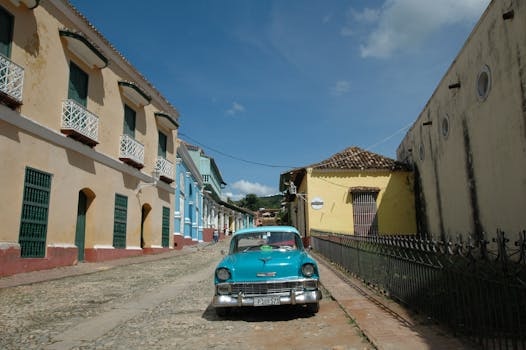Cuba Food Guide
Content Information
Recently updated🔥Current Food Trends 2025
What's happening in Cuba's culinary scene right now
Cuba's culinary scene in 2025 experiences a renaissance as private paladares continue transforming traditional cooking. La Guarida, San Cristobal, and Dona Eutimia lead the movement blending classic Cuban recipes with modern presentation. The rise of fusion cuisine sees Cuban-Asian influences, particularly in Havana's Vedado neighborhood. Street food culture thrives with elevated takes on Cuban sandwiches and tostones. Farm-to-table initiatives connect rural organic farms with urban restaurants despite economic challenges. Traditional mojo sauce gets creative interpretations using tropical fruits beyond citrus. The diaspora influence brings Miami and Spain-inspired techniques back to Cuban kitchens. Craft cocktail culture elevates classic mojitos and daiquiris with artisanal rums and fresh ingredients. November 2025 sees increased culinary tourism focused on authentic home cooking experiences and cigar-pairing dinners. Sustainable seafood practices emerge along coastal fishing communities.
Food Safety Tips
Essential food safety information to help you enjoy Cuba's cuisine safely and confidently.
Drink bottled water.
Tap water in Cuba is generally not safe for consumption by tourists. Stick to bottled or purified water for drinking, brushing teeth, and making ice.
Be cautious of street food.
While street food can be a tempting and authentic experience, be sure to choose vendors that appear clean and hygienic. Look for busy stalls where food is cooked fresh and served hot.
Wash fruits and vegetables thoroughly.
Wash all fresh produce with purified water before consumption to minimize the risk of foodborne illnesses.
Dietary Options
vegetarian
MEDIUM AVAILABILITYVegetarian options are becoming increasingly available in tourist areas and larger cities. Traditional Cuban cuisine relies heavily on meat, but you can find vegetarian dishes featuring rice, beans, plantains, and other vegetables. Be sure to communicate your dietary needs clearly, as the concept of vegetarianism may not be fully understood everywhere.
vegan
LOW AVAILABILITYVegan options are limited in Cuba. While you can find plant-based staples like rice, beans, and vegetables, many dishes contain animal products like lard or chicken broth. It's essential to communicate your dietary restrictions clearly and inquire about ingredients.
Common Allergens
Shellfish
MEDIUM PREVALENCEShellfish, including shrimp, crab, and lobster, are common ingredients in Cuban cuisine, especially in coastal areas. Be sure to check ingredients carefully if you have a shellfish allergy.
COMMONLY FOUND IN:
Peanuts
LOW PREVALENCEPeanuts are not as prevalent in Cuban cuisine as in some other regions, but they can be found in certain desserts and sauces. Always inquire about ingredients if you have a peanut allergy.
COMMONLY FOUND IN:
Essential Food Experiences
These iconic dishes represent the must-have culinary experiences that define Cuba's food culture for travelers.

Ropa Vieja (Old Clothes)
Cuba's national dish featuring shredded beef slow-cooked in a tomato-based sauce with bell peppers, onions, garlic, and spices. Originating from the Canary Islands, the name refers to the appearance of the shredded beef. The Cuban version often includes a splash of beer and annatto for its distinct yellow color. Best enjoyed at La Guarida in Havana, where it's considered the finest in Cuba. Served with rice, black beans, and fried plantains.

Moros y Cristianos (Moors and Christians)
The most commonly eaten food in Cuba, combining white rice (Cristianos) and black beans (Moros) cooked together with garlic, onions, bay leaves, and cumin. Named after the Moors and Christians of Spanish history, this dish symbolizes the cultural blending in Cuban cuisine. Cubans often dress their rice with oil, salt, and vinegar. Served as the foundation of most Cuban meals.

Lechon Asado (Roast Pork)
A festive centerpiece of Cuban celebrations featuring whole pig marinated in mojo (sour orange juice, garlic, oregano, and cumin) then slow-roasted until the skin is crisp and the meat is meltingly tender. Traditionally cooked in a caja china (Chinese box) or over open fire. Essential for holidays, family gatherings, and Christmas Eve. The mojo marinade penetrates deep into the meat, creating incredible flavor.

Cuban Sandwich (Cubano)
Pressed sandwich featuring roasted pork, ham, Swiss cheese, pickles, and mustard on Cuban bread, then grilled until crispy. Originated in Cuban communities in Florida but deeply embraced as Cuban identity. The bread is key - crusty outside, soft inside. Served hot with the cheese melted and bread compressed. Found at street vendors and cafes throughout Havana.

Yuca con Mojo (Cassava with Mojo Sauce)
Boiled cassava root drizzled with garlicky citrus mojo sauce made from sour orange, garlic, olive oil, and cumin. Cassava (yuca) is a starchy root vegetable native to South America and a staple in Cuban cuisine. The mojo sauce adds tangy, aromatic dimension. Often served as a side dish or appetizer in paladares.

Vaca Frita (Fried Cow)
Shredded flank steak marinated in lime and garlic, then pan-fried until crispy. The meat is first boiled, then shredded and crisped in a hot pan with onions. The result is incredibly flavorful with crispy edges and tender center. A favorite at San Cristobal Paladar, where it's served with moros y cristianos and maduros (sweet plantains).

Picadillo a la Habanera (Ground Beef Hash)
Savory ground beef dish seasoned with onions, garlic, tomatoes, olives, raisins, capers, and sweet spices. The combination of sweet raisins with savory olives creates distinctive Cuban flavor. Versatile dish served with rice and plantains or used as filling for empanadas. Reflects Spanish and African influences in Cuban cooking.

Congri (Rice with Red Beans)
Santiago de Cuba's answer to Moros y Cristianos, using red kidney beans instead of black beans cooked with rice, bacon or salt pork, and spices. The dish gets its distinctive color from the red beans. More common in Eastern Cuba, particularly Santiago where Afro-Caribbean influence is strongest. Often cooked in bean broth for added flavor.

Camarones al Ajillo (Garlic Shrimp)
Fresh shrimp sauteed in abundant garlic, olive oil, white wine, and chili flakes. A coastal favorite showcasing Cuba's excellent seafood. The shrimp are cooked quickly to maintain tenderness while the garlic infuses the oil. Served with crusty bread for soaking up the garlicky sauce. Popular at seaside restaurants in Varadero and coastal paladares.

Tostones (Twice-Fried Plantains)
Green plantains sliced, fried once, flattened, then fried again until golden and crispy. Served as a side dish or snack with garlic mojo sauce for dipping. The double-frying creates perfect texture - crispy outside, tender inside. Essential accompaniment to most Cuban meals. Street vendors serve them fresh and hot throughout Havana.

Fufú de Plátano (Mashed Plantain)
Eastern Cuban dish of mashed green plantains mixed with garlic, pork cracklings (chicharrones), and sometimes chicken broth. African in origin, brought by enslaved people to Cuba. The plantains are boiled and mashed similar to mashed potatoes but with distinctive sweetness and garlic punch. Traditional in Santiago de Cuba.
Regional Specialties & Local Favorites
Discover the authentic regional dishes and local favorites that showcase Cuba's diverse culinary traditions.

Arroz con Pollo (Chicken and Rice)
Popular Cuban comfort food of chicken and rice cooked together with saffron or bijol (annatto), bell peppers, tomatoes, peas, and olives. The rice absorbs the chicken flavors creating a one-pot meal. Often includes beer in the cooking liquid. Served at family gatherings and everyday dinners throughout Cuba.

Masas de Puerco (Fried Pork Chunks)
Marinated pork chunks (usually shoulder) fried until crispy outside and tender inside. The pork is marinated in mojo for hours before frying. Served with yuca, moros, and a fresh salad. A Cuban soul food found at local restaurants and home kitchens.

Maduros (Sweet Fried Plantains)
Ripe plantains sliced and fried until caramelized. Unlike tostones, maduros use ripe (black) plantains that are naturally sweet. The frying caramelizes the sugars creating candy-like edges. Essential side dish balancing savory Cuban meals with sweetness.

Ajiaco (Cuban Stew)
Hearty stew considered Cuba's most traditional dish, featuring various meats (beef, pork, chicken), root vegetables (yuca, malanga, boniato), corn, and plantains. Each region adds local ingredients. Slow-cooked for hours until thick and flavorful. Represents Cuba's multicultural heritage in one pot.

Tamal en Cazuela (Cuban Tamale Casserole)
Soft tamale made with fresh corn, not masa, cooked in a pot rather than wrapped. The corn is ground with pork, tomato sauce, and spices into a creamy consistency. Less dense than Mexican tamales. Often served during holidays and special occasions.

Potaje de Frijoles Negros (Black Bean Soup)
Thick, hearty black bean soup seasoned with garlic, cumin, oregano, and bay leaves. Often includes ham hocks or salt pork for flavor. Cooked slowly until creamy. Served over white rice with onions, olive oil, and vinegar on top. A Cuban comfort food staple.

Fricase de Pollo (Chicken Fricassee)
Chicken stewed in wine-based tomato sauce with potatoes, olives, raisins, and bell peppers. Spanish-influenced dish showcasing Cuba's colonial heritage. The chicken is browned first, then simmered until tender. Served with white rice.

Elena Ruz Sandwich
Sweet and savory sandwich created in the 1930s featuring turkey, cream cheese, and strawberry jam on Cuban bread. Named after a socialite who frequented El Carmelo cafe in Vedado. The combination sounds unusual but works beautifully. A Havana specialty found at traditional cafes.
Allergens:
Regional Cuisine Highlights
Explore the diverse culinary landscapes across different regions of Cuba.
Havana
Havana's cuisine reflects its cosmopolitan nature with influences from Spain, Africa, and the Caribbean. As Cuba's capital, it hosts the best paladares including La Guarida, San Cristobal, and Dona Eutimia. Seafood is prominent along the Malecon. Classic Cuban dishes like Ropa Vieja originated here. The city leads Cuba's culinary innovation while honoring traditions.
Cultural Significance:
Havana's cuisine represents the blending of cultures that shaped Cuban identity - Spanish colonial, African enslaved peoples, Caribbean neighbors, and Chinese immigrants all contributed to the city's food culture.
Signature Dishes:
- Ropa Vieja
- Moros y Cristianos
- Cuban Sandwich
- Vaca Frita
Key Ingredients:

Santiago de Cuba
Santiago de Cuba's cuisine is known for spicy, flavorful dishes reflecting strong Afro-Caribbean heritage. Congri (rice with red beans) replaces Moros y Cristianos. More liberal use of peppers and Caribbean spices. The birthplace of Cuban son music and equally rhythmic food culture. Coastal location provides excellent seafood.
Cultural Significance:
Santiago's cuisine showcases the city's rich Afro-Caribbean traditions and its role as Cuba's second city with distinct culinary identity separate from Havana.
Signature Dishes:
- Congri
- Caldosa (spicy seafood stew)
- Fufú de Plátano
- Chilindron de Chivo (goat stew)
Key Ingredients:

Trinidad
Trinidad's cuisine features traditional Cuban dishes with focus on local ingredients from the colonial era. Fresh seafood from the Caribbean coast. Agricultural products from the nearby Escambray Mountains including coffee, sugarcane, and tropical fruits. The preserved colonial architecture extends to preserved culinary traditions.
Cultural Significance:
Trinidad's cuisine highlights the region's colonial heritage and agricultural traditions, maintaining recipes and techniques from Cuba's Spanish colonial period.
Signature Dishes:
- Fresh grilled seafood
- Lechon Asado
- Yuca dishes
- Traditional sweets
Key Ingredients:

Sweet Delights & Desserts
Indulge in Cuba's traditional sweet treats and desserts.

Flan Cubano (Cuban Flan)
Rich and creamy custard dessert with caramel topping. Cuban version is denser and sweeter than Spanish flan, often flavored with condensed milk. The caramel creates a sweet sauce when inverted. Served chilled after meals at paladares and family dinners.

Arroz con Leche (Rice Pudding)
Sweet rice pudding flavored with cinnamon, lemon zest, condensed milk, and sometimes raisins. Cooked slowly until creamy. Served warm or cold with cinnamon sprinkled on top. A comforting home-style dessert found throughout Cuba.

Cake de Ron (Rum Cake)
Moist sponge cake soaked in rum syrup, often made with Cuban rum. Sometimes includes dried fruits and nuts. A decadent dessert enjoyed during celebrations, Christmas, and New Year. The longer it sits, the more the rum flavors develop.

Cascos de Guayaba (Guava Shells)
Peeled guava halves cooked in sugar syrup until tender and translucent. Served with cream cheese and crackers as dessert or snack. The sweet guava contrasts beautifully with tangy cream cheese. A classic Cuban combination found at every celebration.

Dulce de Leche Cortada (Sweet Milk Curd)
Traditional Cuban dessert made by curdling milk with lime juice, then sweetening with sugar and cinnamon. The curds create unique texture. Served in small cups, often during holidays. An economical dessert from times of scarcity that became beloved tradition.
Traditional Beverages
Discover Cuba's traditional drinks, from locally produced spirits to regional wines.

Mojito
Cuba's most famous cocktail made with white rum, fresh mint leaves, sugar, lime juice, and club soda. Invented at La Bodeguita del Medio in Havana. The mint is muddled to release oils, creating refreshing, herbaceous drink. Perfect for warm Caribbean weather. Ernest Hemingway's favorite drink.

Cuba Libre (Rum and Coke)
Simple yet iconic cocktail made with rum, cola, and a squeeze of lime. Created during Cuba's independence from Spain (Cuba Libre means 'Free Cuba'). The lime juice distinguishes it from a basic rum and coke. Best made with Cuban rum and fresh lime.

Daiquiri
Classic cocktail made with rum, lime juice, and sugar, invented in the mining town of Daiquiri near Santiago de Cuba. Can be served shaken over ice (natural) or blended frozen. El Floridita in Havana claims to serve the best daiquiris in the world. Hemingway's custom version included grapefruit juice and no sugar.

Havana Club Rum
Cuba's iconic rum brand produced since 1934. Made from sugarcane juice and aged in oak barrels. Ranges from white rum (3-year) to premium aged rums (15-year and beyond). The base of Cuba's cocktail culture. Sip aged versions neat to appreciate the complexity.
Soft Beverages
Discover Cuba's traditional non-alcoholic drinks, from local teas to refreshing juices.

Guarapo (Sugarcane Juice)
Refreshing drink made from freshly pressed sugarcane. Sold by street vendors throughout Cuba using manual cane presses. The juice is naturally sweet with grassy notes. Sometimes served with lime juice. A quintessential Cuban street beverage, especially popular in summer.

Cafe Cubano (Cuban Coffee)
Strong, sweet espresso-style coffee that's essential to Cuban culture. Made by mixing the first drops of espresso with sugar to create espumita (foam), then adding remaining coffee. Served in small cups throughout the day. Cubans drink it multiple times daily as social ritual.

Batido (Milkshake)
Thick, creamy milkshake made with fresh tropical fruit, milk, ice, and sometimes ice cream. Popular flavors include mamey, guanabana (soursop), mango, and papaya. Found at juice stands and cafeterias throughout Cuba. A refreshing treat in tropical heat.

Malta
Sweet, non-alcoholic malt beverage popular throughout Cuba and the Caribbean. Tastes similar to a sweet, unfermented beer. Often mixed with condensed milk. Believed to have nutritional benefits. Served chilled, especially popular with children.